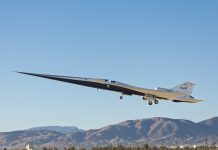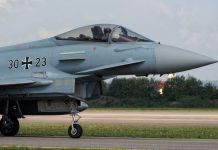Pakistan Air Force (PAF) pilots have begun training on the Chinese FC-31 Gyrfalcon (formerly known as J-31) fighter aircraft in China, Pakistan media is claiming. The media says it could soon be operating the 5th-gen fighters after undergoing training.
In contrast, the delivery of India’s indigenous fighter jet, Light Combat Aircraft LCA MK1A, has been pushed back by a few months. If Indian defense officials are not proactive, they might end up ‘panic buying’ more Rafale fighter jets.
The delay in deliveries of the LCA Mk1A, the advanced variant of LCA ‘Tejas,’ prompted the Vice Chief of the IAF Air Marshal AP Singh to caution that ‘Atma Nirbharta’ (self-reliance) in defense cannot be at the cost of national security.
India has an ambitious lineup of fighter jets. After LCA Mk1A and Mk2, the government has given a nod for the development of the indigenous 5th generation Advanced Medium Combat Aircraft (AMCA).
Both of India’s neighbors are already way ahead in their quest for 5th-generation fighters. China has started deploying its 5th-generation fighter jet J-20 ‘Mighty Dragon’ on its border with India. Pakistan is negotiating with Turkey to get into its 5th-generation fighter jet development program and to buy FC-31 combat jets from China.
IAF experts feel that given the security situation in the country’s neighborhood – its simmering ties with China and Pakistan and the recent coup in Bangladesh calls for some “hard decisions” from India.
According to Bol News:-
"#Pakistan Air Force pilots have begun training in #China for the J-31 Stealth fighter jet"
🇵🇰🤝🇨🇳 pic.twitter.com/sREes3zqgA— 𝐌𝐮𝐡𝐚𝐦𝐦𝐚𝐝 𝐅𝐚𝐢𝐳𝐚𝐧 (@fpa31) August 1, 2024
“India needs to make some hard decisions. LCA Mk1A has been delayed. The production of the aircraft is reliant on the supply of engines by General Electric of the USA. Delays can also be foreseen in the delivery of radars from Israel owing to the ongoing war. The delay in LCA Mk 1A is likely to have a snowballing effect on the LCA Mk2 and AMCA,” former IAF Vice Chief Air Marshal Anil Khosla (retired) told the EurAsian Times.
Khosla believes that “while supporting Atmanirbharta, the minimum deterrence value needs to be maintained.” He suggests procuring another two squadrons of Rafale fighter jets immediately and reviewing the situation subsequently. “This is not panic buying, but it is a necessity,” Air Marshal Khosla adds.
Indian Media has reported that “not a single engine has been received at the moment.” The engines are expected to be delivered from September onwards. In the meantime, the HAL has devised an alternate plan to install used engines on the initial batch of jets.
IAF’s Quest For New Fighter Jets
The IAF, grappling with dwindling fighter squadrons and an aging fleet, has been making a case for the Medium Role Fighter Aircraft (MRFA), seen as the Medium Multi-Role Combat Aircraft (MMRCA) deal re-incarnated.
India’s AMCA Not A 5th-Gen Fighter Jet? Lacks 3 Key Features To Be In The Same League As F-35: OPED
Despite the IAF pushing hard for it, the Indian government, emphasizing “Made in India,” has not budged about purchasing 114 fighter jets from foreign manufacturers at an estimated US$20 billion.
Khosla suggests another two squadrons of Rafale fighter jets are required for the IAF to maintain its combat edge in the region. “Not panic buying, but it is a necessity. A minimum of two more squadrons of Rafale fighter jets are needed immediately, and then the situation can be reviewed subsequently,” Air Marshal Khosla adds. The IAF’s requirement for the 114 MRFA is urgent to maintain a combative edge. Rafale has the advantage that the country’s air force is already operating the aircraft, and the navy will soon be inducting it.
The IAF had proposed in August 2000 to acquire 126 Mirage 2000 II aircraft. The proposal was discarded in 2004, and in 2007, a decision was taken to buy 126 jets under MMRCA.
Previously, the IAF began the process of purchasing new fighter jets under the Medium Multi-Role Combat Aircraft (MMRCA) deal for nearly 15 years before the Indian government scrapped it and purchased 36 Rafales directly from the French government.
The IAF floated the Request for Information in 2018 and received responses from eight aircraft types. The leading contenders in the fray are Dassault’s Rafale, Boeing’s F-15EX, and Saab’s JAS-39 Gripen.
After the aircraft makers’ response, the IAF has set fresh Air Staff Qualitative Requirements (ASQRs) and is awaiting a green signal from the government to send a proposal for an AoN (Acceptance of Necessity).
There has been little forward movement on the MRFA deal for over a year. In the meantime, the IAF fighter squadron strength is down to 31 squadrons against the sanctioned strength of 42. It is looking to retire its Soviet-vintage MiG-21s by 2025, followed by MiG-29s and Jaguars.
By 2027-28, the first of the MiG-29s, inducted in the late 1980s, will start being phased out, and by the early 2040s, some of the earlier batches of SU-30 will also start being phased out.
The IAF has underscored the urgent need for modern fighter platforms at every possible opportunity. And it can be safely said that once the AoN comes from the South Block, which houses the Indian defense ministry, it will take at least 6 to 8 years before the steel birds enter its fleet.
India will need a lot of aircraft to maintain combat parity with the People Liberation Army-Air Force (PLAAF), which remains the IAF’s primary adversary for years to come. However, the IAF still needs to convince the incumbent Indian government that only imported aircraft in such large numbers can meet the need.
Air Marshal Anil Chopra (retired) concurred with the need for new fighter jets for the IAF. “Pakistani training could be premature, but India needs to wake up. As VCAS (Air Marshal AP Singh) said, support ‘Atma Nirbharta,’ but not the cost of capability. We are bound to be forced into panic buying.”
The IAF’s Air Chief Marshal VR Chaudhari reiterated the grim picture over the plummeting squadron numbers in October 2022: “With the given numbers, it may not be possible to maintain a 24/7 combat air patrol or an air defense watch from Sir Creek to Siachen and further to the East. So, the numbers are essential, 42 will remain, though it’s a difficult goal to achieve in the next decade or so, we will review it only based on the situation arising in the neighborhood. Based on the current situation, as per the mandate given to the IAF, we must build up the numbers.”
In comparison, the Pakistan Air Force (PAF) has 20 squadrons with 400 fighter jets and is expected to increase to 24-25 squadrons, with vintage fighters being replaced by J-10C and JF-17 Block III from China. The PLA-Air Force’s fleet has approximately 1,700 fighters, including approximately 150 fifth-generation J-20s and a second fifth-generation fighter, FC-31/J-31, due to enter service soon.

In contrast, the IAF expects the fighter squadron to decrease further by 2029. A representative of the IAF was quoted in the 36th Lok Sabha Report by the Standing Committee on Defence as saying that the induction of LCA and MRFA can arrest the reduction in the IAF’s fighter jet squadrons.
The force is on a good footing when it comes to transporting aircraft, with the induction of the C-17s, C-130s, and C-295. These aircraft have increased the IAF’s global reach. Helicopter strength is also adequate, with the newly inducted helicopters like Chinook and Apache being made in India itself.
The IAF’s Surface-to-air Missile capability has also shown a “healthy trend” and is expected to rise further in the next 10 years.
The IAF’s war endurance capacity needs urgent attention. The force’s deterrence capability has not kept pace with the existing threat perception. The required minimum deterrence through an adequate fighter squadron needs to be maintained at all times, whether by domestic production or outside procurement.
- Ritu Sharma has been a journalist for over a decade, writing on defense, foreign affairs, and nuclear technology.
- The author can be reached at ritu.sharma (at) mail.com
- Follow EurAsian Times on Google News




